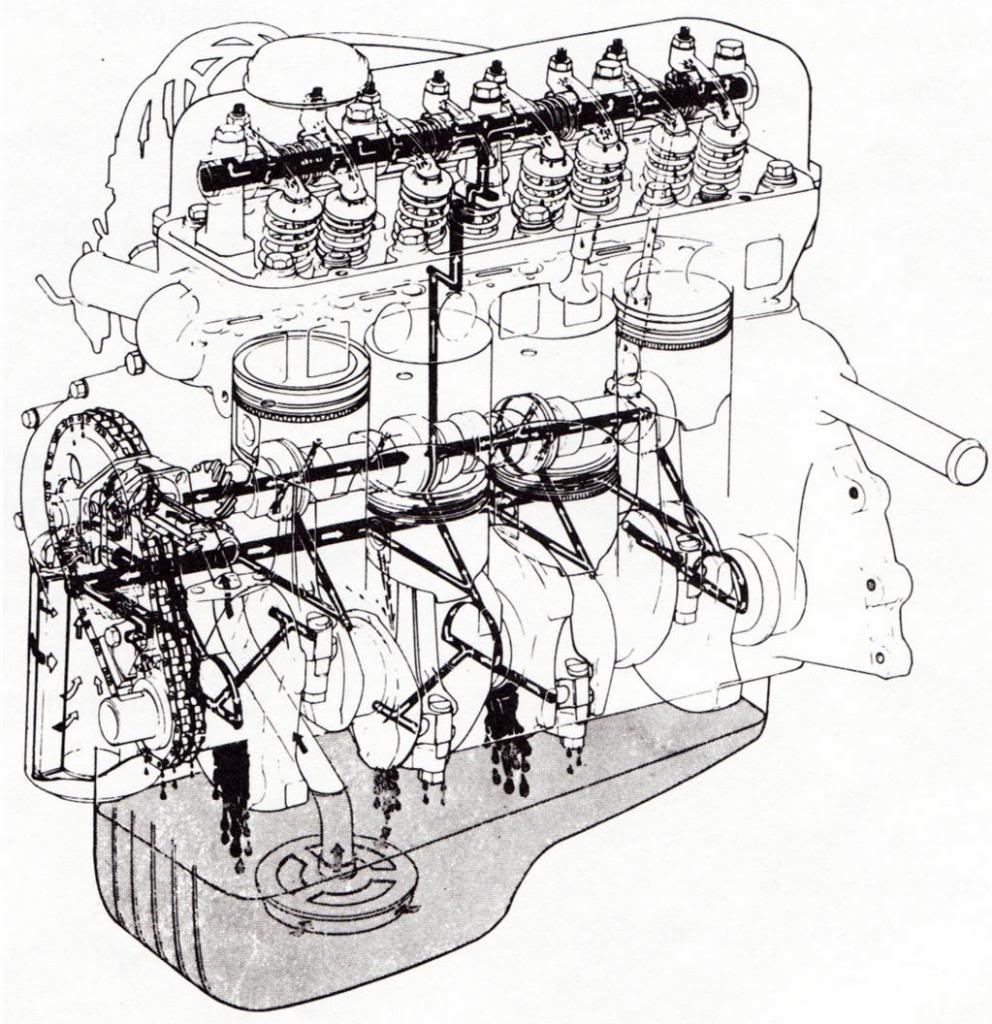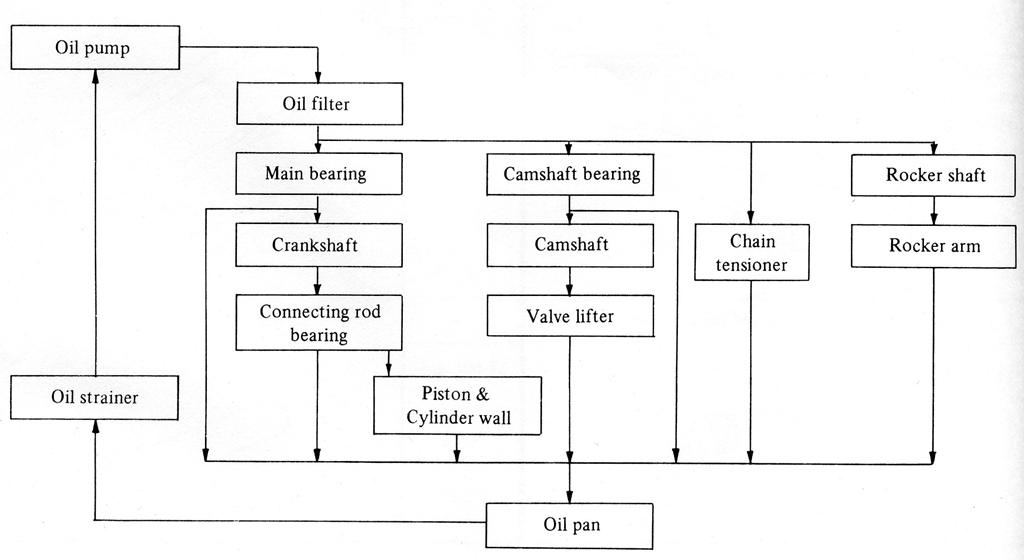Like all modern engines, the A12 has pressure-fed oil circuit -- oil is under pressure from a pump. This allows us to run close-tolerance bearings and achieve high rpms.
Contents |
Overview
The Oil pump attaches to the right-side of the block, below the distributor. It is always below the distributor on all A-series engines because the oil pump is driven by the Distributor drive gear.
The oil pump pickup tube bolts to the underside of the block, and extends into the sump pan.
Lubrication Circuit
Also see: Lubrication System Diagnoses
Sump, Pump and Filter
From the oil sump pan, it is sucked up through the pickup tube. The pickup has a mesh screen (inlet screen) to filter out large debris (should there be any). From there, the oil pump squeezes it into the Oil filter.
Also note that in the Oil pump assembly, the pressure regulator works normally by constantly passing excess oil directly back into the sump, thus regulating pressure. If the regulator gets stuck, you can either get a loss of pressure, no pressure at all, or too high of oil pressure.
In the Oil filter, the oil goes through a filter element. If the filter becomes blocked from dirt, the filter's built-in bypass will open, allowing unfiltered oil into the engine main oil gallery. But normally it goes through the filter element into the engine.
Oil returns to the sump after it runs out the side of the bearings (see more details below).
Main Gallery
From the engine main gallery (feed passage), which mostly runs along the length of the engine, oil goes directly to each main bearing (crankshaft) oiling passage.
From the main bearing, drilled passages in the crank itself leads to each Connecting Rod bearing. From there it travels up inside the rod and sprays a little bit of oil onto the cylinder wall to lubricate the piston rings and cylinder wall-to-piston interface. This is typical for modern engine design.
From the crank and cam bearings, some oil will run out the side of the bearings, and drop back down into the sump. The bearing clearance and design of surfaces surrounding the bearing is designed to control this. Note that if the cam or crank bearings are worn, they will allow more oil than normal to run out the side of the bearings. This will cause low oil pressure, but not "loss of oil" (disappearing oil), since the oil runs back into the sump and is not leaked externally.
From the main oil passage, in addition to feeding the Crank, it also feeds the Camshaft bearings. It feeds a passage drilled down the center of the camshaft, which feeds small passages to each camshaft lobe. So the bottom of the cam followers (cam lifters) are lubricated this way. The top and sides of the lifters are lubricated by oil dripping from above on its way back to the sump (drip-feed, unpressurized oil).
The main oil gallery also feeds the Timing Chain automatic tensioner at the front of the engine. The oil pressure pushes the tensioner towards the chain, taking up slack in the chain. The tensioner pad sprays a little bit of oil on the chain keeping it properly oiled.
The Camshaft oiling passage is drilled up from the center main bearing portion of the engine block. So the cam is lubricated after the crankshaft. This passage goes up, through the cylinder head gasket, through the cylinder head, around the special center head bolt and eventually to the rocker arm shaft, feeding each rocker arm bearing, and a small passage in each rocker feeds the tips of the valves.
After running out of the rocker arm bearings and from the rocker arm-to-valve stem area, the oil is on the top of the cylinder head. Thankfully the top of the head is angled toward the right side, so all the oil runs to that side, and down the holes around the pushrods, back down into the sump completing its journey.
Capacity
A-series engine may seem to run fine with 1 quart/1 litre of oil. So why is a 4-quart capacity used?
- during cornering, when oil runs to the side of the oil pan, the extra capacity means the oil pickup tube won't run dry
- during high-rpm operation when oil is pumped to various locations, there is still sufficient amount left in the sump
- for heat-removal purposes. The engine oil removes heat from the engine
Note that at high RPMs, a considerable amount of oil is pumped above the head and takes a bit of time to return to the sump. So much is being pumped up that it cannot all run down at the same rate. This means two things:
- For racing or high-speed highway driving, be sure the oil level it above the "low" mark on the dipstick. You'll need all the oil the engine was designed for
- For racing you may wish to port and polish the oil drainback holes in the head

![[Datsun 1200 encyclopedia]](/wiki/upload/wiki.png)

